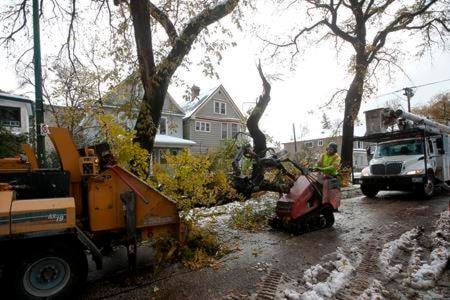WINNIPEG — More Manitoba residents saw their electricity restored Thursday — one week after a major snowstorm brought down power poles and transmission towers and delivered another wallop to farmers.
Manitoba Hydro said some 6,500 homes and businesses remained without power, down from 9,000 Wednesday and 53,000 on Saturday. Most of the remaining outages are in rural areas and First Nations communities in central Manitoba and the Interlake region to the north.
The storm started last Thursday and dumped up to 100 millimetres of rain and snow across a wide swath of the province. Previous wet weather had already saturated the ground, and the storm brought a further halt to fall harvest in many areas.
“We are in emergency mode to get the crops off,” said Bill Campbell, president of Keystone Agricultural Producers of Manitoba, the province’s largest farm group.
“It is absolutely a mess out here and we are really struggling with mental health and how to cope with this.”
The Manitoba government said more than half of flax, soybean and corn crops had yet to be harvested — a level well below the average over the previous three years.
With a hard frost and winter looming, Campbell said many producers are uncertain as to how much of their crops they’ll be able to get to.
“I haven’t spoken to anybody yet that has got less than a quarter-million dollars laying out on the ground. Lots of guys are at half a million,” Campbell said.
“I don’t know what will become of this scenario if we don’t get some really good weather and some favourable government intervention.”
The soaked ground could also raise the risk of spring flooding next year if the ground freezes before it dries.
There are many factors that contribute to the risk of spring flooding in Manitoba, such as the amount of snowfall and how much precipitation falls during the spring melt. The risk is higher in years when the soil is saturated at winter freeze-up because in spring, the ground can’t absorb much of the melting snow and run-off.
Across the central part of the province, many people without power were keeping their homes heated with firewood and relying on generators. Municipalities were reaching out to people short on food and supplies.
About 6,000 people from a dozen First Nations left their homes after the storm, but some have returned.
“Hydro is slowly coming on. I think we’ve got about 60 per cent of the community (reconnected),” said Chief Glenn Hudson of Peguis First Nation, one of the hardest-hit communities.
“There are a few returning home where their homes have been electrified. But we have to assess the homes … in terms of water quality but also if there is any damage as far as flooded basements.”
Elections Canada said it is working with the Canadian Red Cross to ensure those out of their homes will be able to vote in Monday’s federal election at the University of Winnipeg.
This report by The Canadian Press was originally published on Oct. 17, 2019.
Steve Lambert, The Canadian Press
